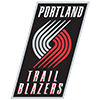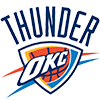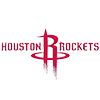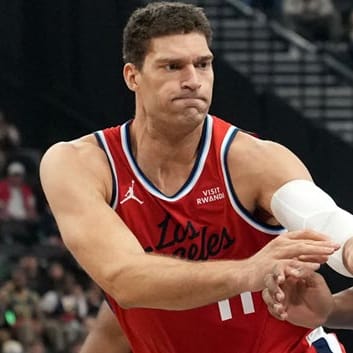Postseason rotations tend to get a lot tighter, but there's still value to be found on each team. Ideally, those plays will match up well with specific weaknesses on the opposition.
The purpose of this two-part series will be to take a bit of a deeper dive into some typically useful DFS metrics and see where there may be exploitable spots that can be attacked with modestly priced players. We reviewed the four Eastern Conference opening-round series in Part 1 and now follow up with an analysis of the Western Conference in Part 2:
 Golden State Warriors (1) vs.
Golden State Warriors (1) vs.  Los Angeles Clippers (8)
Los Angeles Clippers (8)
Season series results: Warriors 3, Clippers 1
Notable Clippers metrics/areas to exploit: Seventh-most points in the paint per game allowed (51.1) on the season/second-highest offensive efficiency rating allowed to opposing frontcourts (85.1) and centers (37.0)
Warriors value plays to consider: Kevon Looney and Jordan Bell, F/ Andrew Bogut, C
Looney and Bell played important roles in the frontcourt rotation at different points throughout the season, while Bogut was a late-season addition brought on largely to serve as experienced depth in the postseason. All three could provide sneaky fantasy value during the first round against a Clippers frontcourt that was vulnerable throughout the campaign.
Looney was solid in four games against Los Angeles, averaging 9.5 points, 5.3 rebounds, 1.3 assists and 1.0 block across 22.3 minutes. Bell finished the regular season with back-to-back double-digit scoring efforts. Bogut averaged a modest 12.2 minutes during the
Postseason rotations tend to get a lot tighter, but there's still value to be found on each team. Ideally, those plays will match up well with specific weaknesses on the opposition.
The purpose of this two-part series will be to take a bit of a deeper dive into some typically useful DFS metrics and see where there may be exploitable spots that can be attacked with modestly priced players. We reviewed the four Eastern Conference opening-round series in Part 1 and now follow up with an analysis of the Western Conference in Part 2:
 Golden State Warriors (1) vs.
Golden State Warriors (1) vs.  Los Angeles Clippers (8)
Los Angeles Clippers (8)
Season series results: Warriors 3, Clippers 1
Notable Clippers metrics/areas to exploit: Seventh-most points in the paint per game allowed (51.1) on the season/second-highest offensive efficiency rating allowed to opposing frontcourts (85.1) and centers (37.0)
Warriors value plays to consider: Kevon Looney and Jordan Bell, F/ Andrew Bogut, C
Looney and Bell played important roles in the frontcourt rotation at different points throughout the season, while Bogut was a late-season addition brought on largely to serve as experienced depth in the postseason. All three could provide sneaky fantasy value during the first round against a Clippers frontcourt that was vulnerable throughout the campaign.
Looney was solid in four games against Los Angeles, averaging 9.5 points, 5.3 rebounds, 1.3 assists and 1.0 block across 22.3 minutes. Bell finished the regular season with back-to-back double-digit scoring efforts. Bogut averaged a modest 12.2 minutes during the 11 games he played in the regular season, and he could offer valuable minutes behind DeMarcus Cousins during the first round.
What's more, all three players scored 70.0 percent or more of their points in the paint this season, making them capable of exploiting Los Angeles' weakness in that area.
 Denver Nuggets (2) vs.
Denver Nuggets (2) vs.  San Antonio Spurs (7)
San Antonio Spurs (7)
Season series results: Nuggets 2, Spurs 2
Notable Nuggets metrics/areas to exploit: Third-highest offensive efficiency rating allowed to small forwards (23.0)/Fourth-highest shooting percentage (45.7) allowed to small forwards
Spurs value play to consider: Rudy Gay, SF
The Nuggets played rock-solid defense overall, but defending small forwards was a weakness. Gay enjoyed a bounce-back season, posting a career-best 50.4 percent success rate from the field, including a career-high 40.2 percent from behind the arc. He also pulled down a career-high 6.8 rebounds per contest and logged at least eight boards in nine of the last 11 games of the season. Gay averaged 26.7 minutes per game during the season and should see a similar allotment in the postseason.
Notable Spurs metrics/areas to exploit: Eighth-highest offensive efficiency rating allowed to point guards (26.1)/10th-highest offensive efficiency rating allowed to opposing backcourts (48.5)
Nuggets value play to consider: Monte Morris, PG
Morris broke out this season with averages of 10.4 points, 3.6 assists and 2.4 rebounds across 24.0 minutes per contest while shooting an impressive 49.3 percent, including 41.4 percent from three-point range. He's solidified his role as one of the leaders of the second unit behind Jamal Murray and shot 52.1 percent over the last 18 games of the regular season. He also averaged 11.3 points in four games against the Spurs and should be locked into a very similar role to that which he enjoyed in the regular season.
 Portland Trail Blazers (3) vs.
Portland Trail Blazers (3) vs.  Oklahoma City Thunder (6)
Oklahoma City Thunder (6)
Season series result: Thunder 4, Trail Blazers 0
Notable Trail Blazers metrics/areas to exploit: 10-highest shooting percentage allowed to power forwards (46.9), including eighth-highest from three-point range (36.0)
Thunder value plays to consider: Jerami Grant and Markieff Morris, PF
Grant posted career bests across the stat sheet while starting all but the first three games of the season. The floor-spacing big drained a career-high 39.2 percent from three-point range on an average of 3.7 attempts per contest. He also shot 54.2 percent, including 50.0 percent from distance, in three games against Portland.
Meanwhile, Morris got off to a slow start with the Thunder, but he bounced back to average 10.8 points (on 50.0 percent shooting, including 45.5 percent from distance), 7.0 rebounds and 1.3 assists over the last four games of the regular season. Like Grant, Morris is capable of exploiting the Blazers' weakness defending power forwards.
Notable Thunder metrics/areas to exploit: Fifth-highest shooting percentage allowed to power forwards (47.7)
Trail Blazers value plays to consider: Al-Farouq Aminu and Jake Layman, PF
The other side of the matchup down low bodes well for a couple of Blazers as well. Aminu averaged 10.5 points, 11.5 rebounds and 2.0 assists in four games versus the Thunder, while Layman was efficient in averaging 8.0 points on 50.0 percent shooting across just 18.5 minutes in four games against OKC as well. Both players also averaged just under a fantasy point per minute on DraftKings without Jusuf Nurkic (leg) on the floor this season, and Layman actually averaged 1.01 per minute on FanDuel without the big man.
 Houston Rockets (4) vs.
Houston Rockets (4) vs.  Utah Jazz (5)
Utah Jazz (5)
Season series result: Rockets 2, Jazz 2
Notable Rockets metrics/areas to exploit: Seventh-highest offensive efficiency rating allowed to small forwards (22.3)/ Third-most points in the paint per game allowed (51.9), including the most at home (52.6)
Jazz value plays to consider: Royce O'Neale, Derrick Favors, Jae Crowder, F
O'Neale averaged a solid 20.4 minutes this season and boosted his shooting percentage to a career-best 47.5 percent, including 38.6 percent from three-point range. The second-year wing is capable of checking off every box on the stat sheet and should fill his usual role on the second unit during the first round.
Meanwhile, both Crowder and Favors should continue splitting minutes fairly evenly in the frontcourt despite Favors nursing a back injury toward the end of the regular season. Favors particularly should be able to exploit the Rockets' vulnerability to allowing points down low, as he logged 72.5 percent of his scoring in the paint and shot 70.8 percent across four games versus Houston this season. For his part, Crowder averaged 11.5 points, 6.5 rebounds, 1.8 steals and 1.3 assists in four games against the Rockets.
Notable Jazz metric/area to exploit: Fourth-highest three-point percentage allowed to point guards (37.5)
Rockets value play to consider: Austin Rivers, PG
The Jazz don't have many statistical weaknesses that stand out, but their defense versus long-distance shooting from point guards is interestingly one of them. Rivers happens to be capable of capitalizing, as he typically shows no hesitation in firing away from behind the arc. The veteran shot just 31.8 percent from three-point range this season, but he took the second-highest number of shot from behind the arc (4.3) of his career. Additionally, Rivers logged 20 minutes or more in eight of the last nine games of the season, and he scored 16 points while shooting 50.0 percent from three-point range in his one game versus Utah this season.








































